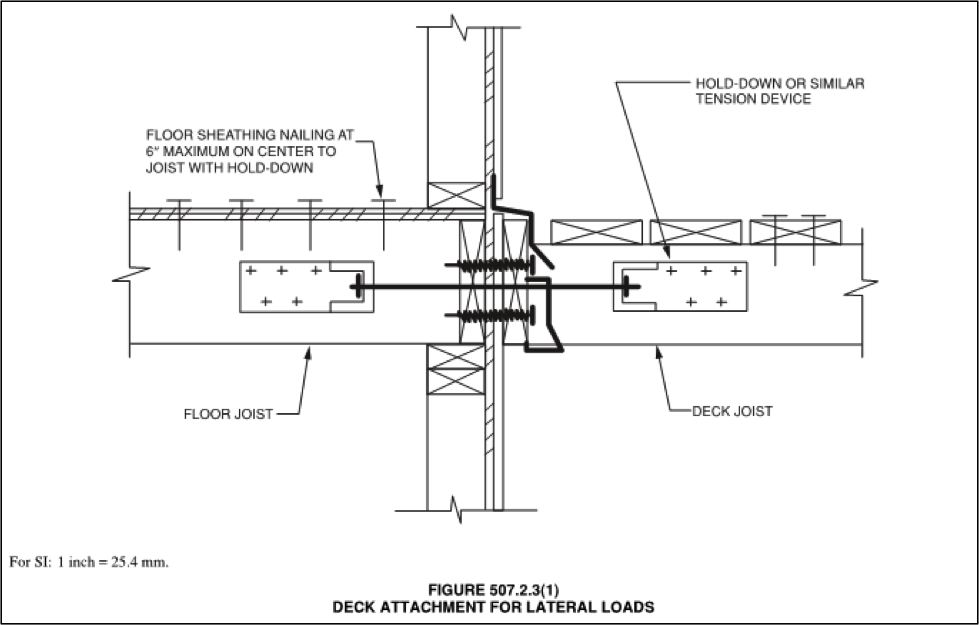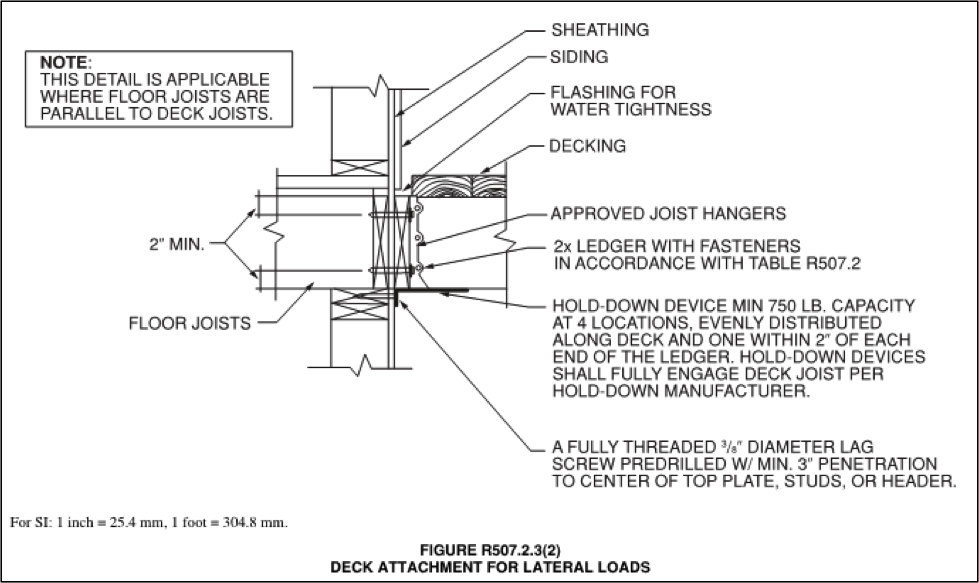Early this summer a package arrived at my office that I knew right away was either a copy of a new building code or design standard. Some codes or standards are more exciting than others to open up and see what’s new and different. As it turns out, this package was the just-published 2015 International Residential Code (IRC). With my interest in wood decks, I have to admit that this was new information that I was happy to see.
Why? Similar to my blog post in May mentioning the limited design resources currently available to engineers, the IRC itself is also a work in progress when it comes to the prescriptive details included for decks. Performance requirements for the framing and guards has always been included in Chapter 3, but it wasn’t until the 2009 and 2012 editions that prescriptive information for attaching a deck ledger to a wood band joist with lag screws or bolts, and a detail for transferring lateral loads to a support structure, were included. Key improvements for the 2015 IRC include provisions for composite materials, clarification of the prescriptive ledger information, and prescriptive information for decking, joist and beam allowable spans, post heights and foundations.
Lateral load connections at the support structure were a significant topic during the development of the 2015 IRC. The permitted method already in the code involves constructing the Figure 507.2.3(1) detail with 1,500 pound hold-downs, in two or more locations per deck. The detail transfers the lateral load by bypassing the joist hanger and ledger connections, and ultimately transfers it into the floor diaphragm of the support structure. The concentrated nailing on the floor joist and the need to have access from below to the install the hold-down can cause undesirable complications for builders with existing conditions. A number of common conditions also differ significantly from the detail, such as the floor joists running parallel to the deck ledger and alternate floor joist types, including i-joists or trusses. In response to frequently-asked-questions from the industry, our technical bulletin T-DECKLATLOAD provides commentary to consider for these situations. The technical bulletin also offers an alternate floor joist-to-sheathing connection that may save the builder from removing a finished floor in an existing condition or from adding additional sheathing nailing from above.

In order to provide greater flexibility, a second option is now included in the 2015 IRC: constructing Figure R507.2.3(2) with 750 pound hold-downs in four locations per deck. This detail also transfers the lateral load in bypassing the joist hanger and ledger connections, but transfers the load to the wall plates, studs, or wall header by means of a screw anchoring the hold-down. In some cases, builders will hope this detail can save removing interior portions of an existing structure, but close attention will be required in terms of the deck joist elevation with respect to components of the wall and ensuring that hold-down anchor has proper penetration into the wall framing.

There are still a number of scenarios where a residential deck builder may need or want to consider hiring a structural engineer. Prescriptive details for guards and stairs are still not included in the code, as well as lateral considerations such as the deck diaphragm or the stability of a freestanding deck. Alternate loading conditions, such as the future presence of a hot tub, are also outside the scope of the current code. The allowance for alternative means and methods permitted by Chapter 3 of the 2015 IRC, is also something to keep in mind when the prescriptive options do not fit well with the project conditions. For example, the IRC ledger fastening table applies for connections to a band joist only and not to wall studs or other members of the adjacent support structure.
Have you been involved with any residential deck projects? Let us know in the comments section below.




I thought that someone had copied the Simpson tension detail for lateral, above, from one of my residential drawing sheets. Glad I did it correctly!
Re the second figure above, what Strong-Tie hold-down device might be suitable?
Never mind, found it – DTT1Z.
Hi, forgive my ignorance as i am not a contractor… I recently bought a small place on a lake. The deck is nearly completely rotten. This house has an 8′ extension past the foundation which is supported by 6×6’s. The deck mirrors the entire length of the house. Is it true that i can only attach the deck to the portion of the house which is attached to the foundation? Does the 8 foot section have to be free standing?
Gary
Hi Gary,
When an adjacent structure is used to support a deck, the adjacent
structure is typically continuously supported by a foundation along the line of the deck attachment. We would recommend you consult with a design professional to determine if the house framing can support a portion of the deck, or if the deck should be free standing without support from the house.
Thanks!
This new alternate detail only applies where floor joists are parallel to deck joists? Still out of luck when floor joists are parallel to the rim joist?
RIDICULOUS. ICC AND SIMPSON COME UP WITH ANOTHER WAY TO MAKE MONEY. IF INSPECTORS AND BIG BUILDERS HADN’T CLOSED THEIR EYES IN PAST YEARS, WE WOULDN’T BE BACKTRACKING AND TRYING TO BULLETPROOF DECKS. IF DECKS ARE BUILT WITH PROPER HARDWARE AND MATERIALS, THEY SHOULD LAST A LONG TIME. I’VE REPLACED MANY BUILDER DECKS LESS THAN 10 YEARS OLD THAT LOOK LIKE MY 6 YEAR OLD BUILT THEM. LETS GET THE BUILDERS TO START PUTTING UP DECKS THAT LAST AND HIRING CONTRACTORS THAT KNOW HOW TO BUILD THEM! FURTHERMORE THE INSPECTORS THAT TURN A BLIND EYE TO SHOTTY WORK, NOBODY WANTS TO TALK ABOUT THAT. ULTIMATELY IT’S THEIR RESPONSIBILITY TO MAKE SURE THE DECKS ARE SAFE FOR PEOPLE TO USE THEM. QUIT COMING DOWN ON THE RESPONSIBLE CONTRACTORS AND MAKING IT ALMOST IMPOSSIBLE TO CONSTRUCT A SIMPLE DECK. GET TO THE ROOT OF THE PROBLEM. SIMPSON SHOULD BE ASHAMED AT THEMSELVES FOR TRYING TO ACHIEVE MAXIMUM PROFIT. IF THEIR EXISTING PRODUCTS ARE USED PROPERLY, THERE SHOULDN’T BE ANY PROBLEMS. I PERSONALLY HAVE INSTALLED HUNDREDS OF DECKS AND NEVER HAD ANY STRUCTURAL ISSUES.
Thanks for reaching out to us. We completely agree with you that decks built with the proper hardware and materials should last a long time and that there are many good contractors who know how to do this. Unfortunately, as you mention, not all contractors know how to build a safe strong deck. At Simpson Strong-Tie we are committed to building safer, stronger structures – including decks. That is why we support appropriate code requirements and offer construction industry professionals many free resources like our Deck Center to help ensure decks are safe, meet the code and will last a long time for homeowners. You can check it out here: http://www.strongtie.com/products/deckcenter. We offer a multitude of products and ways to achieve a safe strong deck for homeowners that suit their lifestyle and needs. Your comments are appreciated and we think your feedback is important. If you have any further questions, feel free to contact our Social Media Manager at mel-rahman@strongtie.com.